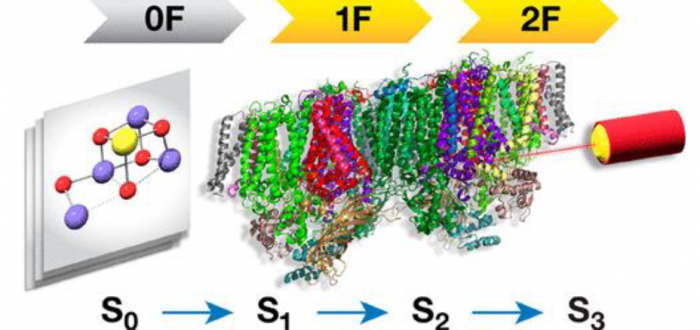Protein crystallography of PSII only recently has made significant progress. Starting from the first low-resolution crystallographic models of PSII in 2001, obtained with conventional synchrotron radiation sources, the field has moved through gradual improvements to the current era of X-ray free-electron laser (XFEL) sources, providing the first geometric models of the S1-state in the oxygen-evolving complex (OEC). The advent of serial femtosecond crystallography (SFX) has more recently enabled attempts at characterizing models for the S2 (1-flash, 1F), S3 (2F), and S0 (3F) intermediates. Discrepancies among SFX-XFEL studies and an apparent lack of consistency with spectroscopic Oxidation States (OSs) has fueled ongoing debates about the nature of the highly contested S3 state and about the mechanism of O-O bond formation itself.
In this work the authors use a comprehensive array of methods, ranging from structure-based analysis and Mn(III) distortion metrics to evaluation of electronic structure and magnetic/spectroscopic properties. Among others they employ an effective oxidation state analysis applied for the first time to the OEC. The results highlight severe limitations and occasional complete breakdowns in the connection between geometry and electronic structure for the available crystallographic models of the 1F (“S2”) but also of the 0F (“S1”) states. The available models appear to be over-reduced; they do not clearly reflect one-electron oxidation in the S1 to S2 transition, and they do not feature well defined Mn OSs or electron counts. These fundamental problems and the discrepancies observed between PSII monomers suggest that the existing SFX-XFEL models should not be used as a basis to extract conclusions concerning electronic structure features.
This work has been performed in collaboration with Dr. Maria Drosou, Prof. Dr. Frank Neese and Dr. Dimitrios Pantazis from the Max-Planck-Institut für Kohlenforschung where the PhD student Gerard Comas from the Institute of Computational Chemistry and Catalysis of the University of Girona under the supervision of Dr. Pedro Salvador carried out a research stay for 3 months. It has recently been published in the Journal of the American Chemical Society:
M. Drosou, G. Comas-Vilà, F. Neese, P. Salvador*, and D. A. Pantazis*
“Does Serial Femtosecond Crystallography Depict State-Specific Catalytic Intermediates of the Oxygen-Evolving Complex?”
J. Am. Chem. Soc., 2023, ASAP
DOI: 10.1021/jacs.3c00489
Girona, May 15, 2023
For more info: gestor.iqcc@gmail.com

